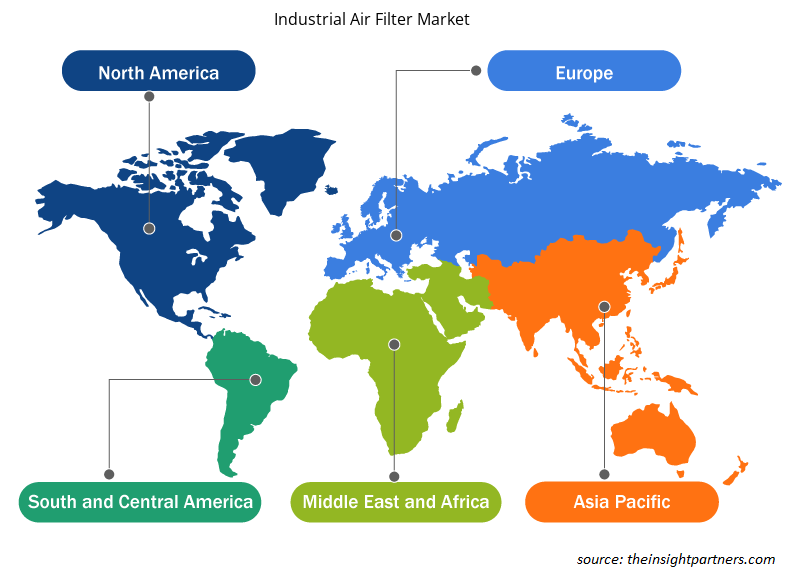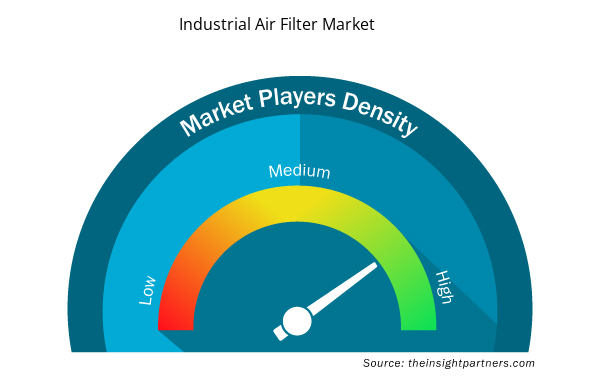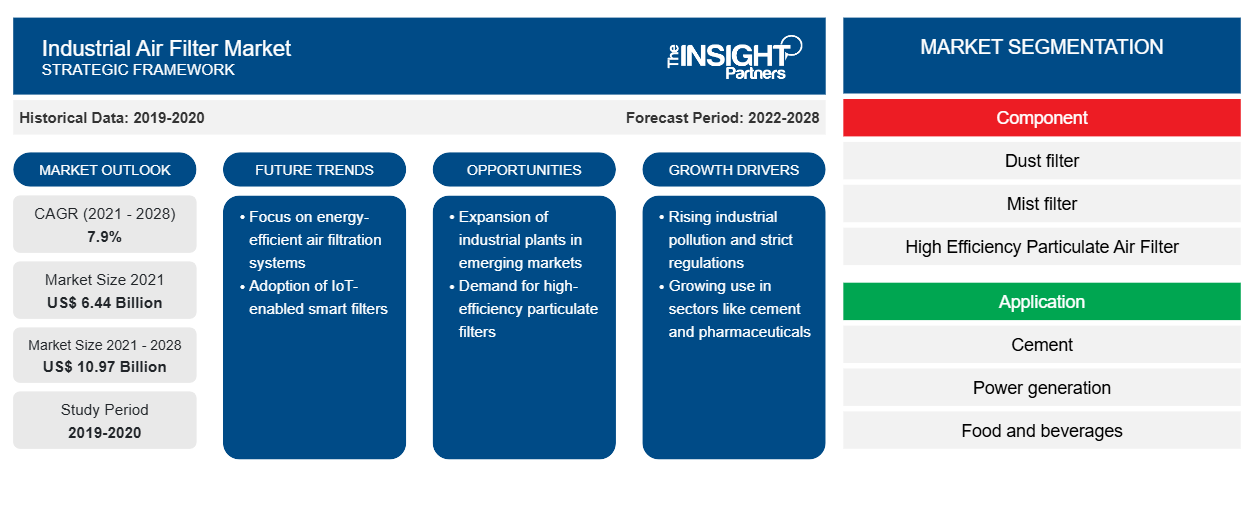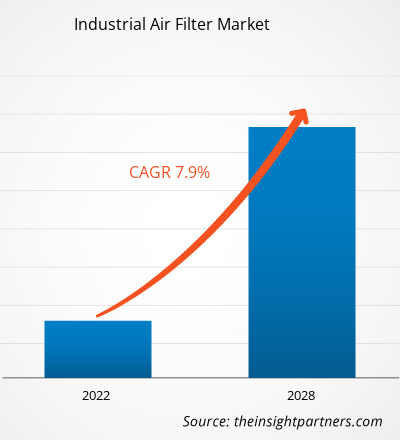[Rapporto di ricerca] Si prevede che il mercato dei filtri dell'aria industriali crescerà da 6,44 miliardi di dollari nel 2021 a 10,97 miliardi di dollari entro il 2028; si stima che crescerà a un CAGR del 7,9% nel periodo 2021-2028.
Prospettiva dell'analista:
Il mercato dei filtri dell'aria industriali è cresciuto notevolmente e si è espanso negli ultimi anni. Ciò può essere attribuito a diversi fattori chiave che guidano la domanda di sistemi di filtraggio dell'aria in contesti industriali. Uno dei principali fattori trainanti è il rapido ritmo dell'industrializzazione in vari settori in tutto il mondo. Con l'espansione delle industrie e l'intensificazione dei processi di produzione, aumentano gli inquinanti e i contaminanti presenti nell'aria. Ciò richiede l'implementazione di sistemi di filtraggio dell'aria efficaci per mantenere una qualità dell'aria ottimale e proteggere la salute dei lavoratori. Un altro fattore significativo che contribuisce alla crescita del mercato è il rafforzamento degli standard e delle normative sulla qualità dell'aria delle agenzie governative e ambientali. Queste normative mirano a ridurre al minimo le emissioni e gli inquinanti rilasciati nell'atmosfera dalle operazioni industriali. Di conseguenza, le industrie sono costrette a investire in tecnologie avanzate di filtraggio dell'aria per conformarsi a questi rigorosi standard.
Inoltre, c'è una crescente consapevolezza tra gli stakeholder industriali circa gli effetti dannosi della scarsa qualità dell'aria sulla produttività, sul benessere dei lavoratori e sull'efficienza operativa complessiva. I filtri dell'aria industriali svolgono un ruolo cruciale nella rimozione di particelle nocive dall'aria, come polvere, fumo, sostanze chimiche e allergeni, creando un ambiente di lavoro più sano e sicuro. Il mercato dei filtri dell'aria industriali comprende vari prodotti che soddisfano i diversi settori industriali, tra cui produzione, automotive, farmaceutica, lavorazione alimentare, impianti chimici ed elettronica. Questi filtri variano in dimensioni, efficienza e tecnologia, a seconda dei requisiti specifici di ciascun settore.
Panoramica del mercato:
Per migliorare la qualità dell'aria interna ed esterna, i filtri dell'aria riducono o rimuovono le impurità dall'aria. Qualsiasi sistema di riscaldamento, ventilazione e aria condizionata necessita di filtri dell'aria industriali per rimuovere le particelle estranee dall'aria. I filtri dell'aria industriali sono fondamentali in qualsiasi attività in cui i processi producono fumo e inquinanti. Questi filtri mantengono la qualità dell'aria interna (IAQ) in ambienti chiusi filtrando contaminanti come polline, polvere e inquinanti chimici. I filtri dell'aria industriali impediscono inoltre agli inquinanti di entrare nei macchinari industriali , riducendo il rischio di danni ai macchinari causati da grandi particelle estranee.
Personalizza questo report in base alle tue esigenze
Riceverai la personalizzazione gratuita di qualsiasi report, comprese parti di questo report, o analisi a livello nazionale, pacchetto dati Excel, oltre a usufruire di grandi offerte e sconti per start-up e università
- Scopri le principali tendenze di mercato in questo rapporto.Questo campione GRATUITO includerà analisi di dati che spaziano dalle tendenze di mercato alle stime e alle previsioni.
Fattore trainante del mercato:
La crescente consapevolezza della salute e della sicurezza guiderà la crescita del mercato dei filtri dell'aria industriali
La crescente consapevolezza della salute e della sicurezza negli ambienti industriali gioca un ruolo significativo nel guidare la crescita del mercato dei filtri dell'aria industriali. Man mano che le organizzazioni e le industrie diventano più consapevoli dell'impatto della qualità dell'aria sul benessere e sulla sicurezza dei loro lavoratori, c'è una maggiore enfasi sulla creazione di ambienti interni puliti e sani. Questa consapevolezza porta a una maggiore domanda di sistemi di filtraggio dell'aria efficaci, alimentando così la crescita del mercato. Le organizzazioni danno priorità al benessere della loro forza lavoro, riconoscendo che una scarsa qualità dell'aria può causare problemi respiratori, allergie e malattie professionali. Investendo in sistemi di filtraggio dell'aria di alta qualità, le aziende mirano a migliorare la qualità dell'aria interna e fornire un ambiente di lavoro sicuro per i loro dipendenti. Questa attenzione al benessere dei lavoratori guida la domanda di filtri dell'aria industriali, contribuendo alla crescita del mercato.
I governi e gli enti normativi impongono rigide normative sulla salute e sicurezza sul lavoro. Tali normative spesso includono requisiti specifici per il mantenimento di standard accettabili di qualità dell'aria in contesti industriali. Le organizzazioni devono sottostare a tali normative per evitare sanzioni e responsabilità legali. C'è una crescente domanda di sistemi di filtraggio dell'aria efficaci per soddisfare questi requisiti di conformità, il che stimola ulteriormente la crescita del mercato. Anche la qualità dell'aria interna pulita e sana influisce direttamente sulla produttività dei lavoratori e sull'efficienza operativa complessiva. Quando i dipendenti sono esposti all'aria pulita, hanno meno problemi di salute, una minore stanchezza e una migliore concentrazione e attenzione. Riconoscendo ciò, le organizzazioni investono in filtri dell'aria industriali per ottimizzare le prestazioni della propria forza lavoro, migliorando in definitiva la produttività e l'efficienza operativa.
Inoltre, le organizzazioni che danno priorità alla salute e alla sicurezza dei propri dipendenti possono costruire una reputazione e un'immagine di marca positive. Consumatori, investitori e talenti sono sempre più propensi a supportare le aziende impegnate nel benessere dei lavoratori e nella sostenibilità ambientale. Investendo in sistemi avanzati di filtraggio dell'aria per fornire un ambiente di lavoro pulito e sano, le aziende possono migliorare la propria reputazione e ottenere un vantaggio competitivo sul mercato. La crescente consapevolezza della salute e della sicurezza negli ambienti industriali riflette anche le mutevoli preferenze dei consumatori. I consumatori sono ora più consapevoli dei prodotti che acquistano e delle aziende che supportano. Preferiscono le aziende che danno priorità al benessere dei lavoratori e alla responsabilità ambientale. Pertanto, le organizzazioni impegnate a fornire una qualità dell'aria pulita e sana attraverso filtri dell'aria industriali possono allinearsi a queste preferenze dei consumatori, posizionandosi favorevolmente sul mercato.
Analisi segmentale:
In base al prodotto, il mercato dei filtri dell'aria industriali è suddiviso in filtri antipolvere, filtri antinebbia, filtri a maniche, collettori e filtri a cartuccia (CC e F), filtri HEPA, scrubber a umido e scrubber a secco. Il segmento degli scrubber a umido ha detenuto la quota maggiore del mercato nel 2020 e si prevede che registrerà il CAGR più elevato nel mercato durante il periodo di previsione. Gli scrubber a umido sono emersi come il segmento di mercato dominante dei filtri dell'aria industriali per diversi motivi. Offrono elevata efficienza nella rimozione dei contaminanti, versatilità in tutti i settori e conformità alle severe normative sulle emissioni. Gli scrubber a umido eliminano efficacemente le sostanze pericolose e controllano il particolato, rendendoli una scelta preferita per vari settori industriali. I progressi tecnologici, l'economicità e i vantaggi a lungo termine dominano ulteriormente il loro mercato. Nel complesso, le capacità complete di rimozione degli inquinanti degli scrubber a umido e le applicazioni diffuse hanno assicurato la loro posizione come soluzione leader nel mercato dei filtri dell'aria industriali.
Analisi regionale:
Il mercato dei filtri dell'aria industriali del Nord America è stato valutato a 2,10 miliardi di $ nel 2021 e si prevede che raggiungerà i 3,45 milioni di $ entro il 2028; si prevede che crescerà a un CAGR del 7,4% durante il periodo di previsione. La regione del Nord America è emersa come mercato dominante nel settore dei filtri dell'aria industriali, principalmente a causa di diversi fattori chiave che contribuiscono alla sua posizione di leader. In primo luogo, il Nord America è noto per l'implementazione di severe normative ambientali, in particolare in paesi come gli Stati Uniti e il Canada. Queste normative mirano a controllare e ridurre l'inquinamento atmosferico, migliorare la qualità dell'aria e proteggere la salute pubblica. I settori industriali del Nord America sono tenuti a rispettare questi rigorosi standard sulle emissioni, il che determina la domanda di tecnologie avanzate di filtrazione dell'aria. Le aziende della regione danno priorità all'aderenza a queste normative, il che porta a un tasso di adozione più elevato di filtri dell'aria industriali. In secondo luogo, il Nord America ha un settore industriale ben sviluppato e diversificato. L'elevata industrializzazione e attività industriale nel Nord America si traduce in emissioni e inquinanti significativi rilasciati nell'atmosfera. Per affrontare le preoccupazioni ambientali e proteggere la salute dei lavoratori, le industrie del Nord America investono in sistemi avanzati di filtraggio dell'aria. Pertanto, la domanda di filtri industriali per l'aria è più alta in questa regione che in altre.
Inoltre, il Nord America è caratterizzato da una cultura di progressi tecnologici e innovazione. La regione ha una solida infrastruttura di ricerca e sviluppo, che consente lo sviluppo continuo di tecnologie di filtrazione dell'aria all'avanguardia. I produttori del Nord America sono in prima linea nello sviluppo e nella commercializzazione di soluzioni di filtrazione avanzate che forniscono elevata efficienza e prestazioni migliorate. Questa leadership tecnologica offre alle aziende nordamericane un vantaggio competitivo e contribuisce al predominio del mercato dei filtri dell'aria industriali della regione. Inoltre, la crescente consapevolezza dell'importanza della qualità dell'aria nel Nord America è stata una forza trainante dietro la crescente adozione di filtri dell'aria industriali. Sia le industrie che gli individui riconoscono sempre di più i benefici per la salute e l'ambiente dell'aria pulita. Questa maggiore consapevolezza ha portato a una maggiore domanda di soluzioni di filtrazione dell'aria, spingendo ulteriormente la crescita del mercato nel Nord America.
Analisi dei giocatori chiave:
L'analisi del mercato dei filtri dell'aria industriali è composta da attori quali Honeywell International Inc, MANN+HUMMEL International GmbH & Co, Beko Technologies, Sentry Air Systems, Nordic Air Filteration A/S, Donaldson Company, Filtration Group Industrial, Pall Corporation, General Filter Italia e Camfil. Tra gli attori del mercato dei filtri dell'aria industriali, Honeywell International Inc e Donaldson Company sono i due principali attori grazie al portafoglio di prodotti diversificato offerto.
Approfondimenti regionali sul mercato dei filtri dell'aria industriali
Le tendenze regionali e i fattori che influenzano il mercato dei filtri aria industriali durante il periodo di previsione sono stati ampiamente spiegati dagli analisti di Insight Partners. Questa sezione discute anche i segmenti e la geografia del mercato dei filtri aria industriali in Nord America, Europa, Asia Pacifico, Medio Oriente e Africa e America centrale e meridionale.

- Ottieni i dati specifici regionali per il mercato dei filtri dell'aria industriali
Ambito del rapporto sul mercato dei filtri dell'aria industriali
| Attributo del report | Dettagli |
|---|---|
| Dimensioni del mercato nel 2021 | 6,44 miliardi di dollari USA |
| Dimensioni del mercato entro il 2028 | 10,97 miliardi di dollari USA |
| CAGR globale (2021 - 2028) | 7,9% |
| Dati storici | 2019-2020 |
| Periodo di previsione | 2022-2028 |
| Segmenti coperti | Per componente
|
| Regioni e Paesi coperti | America del Nord
|
| Leader di mercato e profili aziendali chiave |
|
Densità degli attori del mercato dei filtri dell'aria industriali: comprendere il suo impatto sulle dinamiche aziendali
Il mercato dei filtri dell'aria industriali sta crescendo rapidamente, spinto dalla crescente domanda degli utenti finali dovuta a fattori quali l'evoluzione delle preferenze dei consumatori, i progressi tecnologici e una maggiore consapevolezza dei vantaggi del prodotto. Con l'aumento della domanda, le aziende stanno ampliando le loro offerte, innovando per soddisfare le esigenze dei consumatori e capitalizzando sulle tendenze emergenti, il che alimenta ulteriormente la crescita del mercato.
La densità degli operatori di mercato si riferisce alla distribuzione di aziende o società che operano in un particolare mercato o settore. Indica quanti concorrenti (operatori di mercato) sono presenti in un dato spazio di mercato in relazione alle sue dimensioni o al valore di mercato totale.
Le principali aziende che operano nel mercato dei filtri dell'aria industriali sono:
- Honeywell International, Inc.
- Mann + Hummel GmbH
- FILTRAZIONE DELL'ARIA NORDICA
- Società Donaldson, Inc.
- GENERAL FILTER ITALIA
Disclaimer : le aziende elencate sopra non sono classificate secondo un ordine particolare.

- Ottieni una panoramica dei principali attori del mercato dei filtri dell'aria industriali
Sviluppi recenti:
Le strategie inorganiche e organiche come fusioni e acquisizioni sono ampiamente adottate dalle aziende nel mercato dei filtri aria industriali. Di seguito sono elencati alcuni recenti sviluppi chiave del mercato:
- A novembre 2021, Alfa Laval ha rafforzato il suo portafoglio GNL con l'unità di combustione del gas 2.0. Questo nuovo investimento aiuterà l'azienda ad espandere il suo territorio in diversi paesi del Golfo.
- A settembre 2021, Eaton ha introdotto una nuova valvola combinata compatta a perdite zero che scarica in modo sicuro i vapori di carburante evaporativi dannosi nel serbatoio impilando una valvola di sfiato con limite di riempimento (FLVV) e una nuova valvola di sfiato di grado a perdite zero (GVV)
- Analisi storica (2 anni), anno base, previsione (7 anni) con CAGR
- Analisi PEST e SWOT
- Valore/volume delle dimensioni del mercato - Globale, regionale, nazionale
- Industria e panorama competitivo
- Set di dati Excel


- Intradermal Injection Market
- Print Management Software Market
- Single-Use Negative Pressure Wound Therapy Devices Market
- Wind Turbine Composites Market
- Portable Power Station Market
- Analog-to-Digital Converter Market
- Vision Care Market
- Online Exam Proctoring Market
- Mice Model Market
- Procedure Trays Market

Report Coverage
Revenue forecast, Company Analysis, Industry landscape, Growth factors, and Trends

Segment Covered
This text is related
to segments covered.

Regional Scope
North America, Europe, Asia Pacific, Middle East & Africa, South & Central America

Country Scope
This text is related
to country scope.
Domande frequenti
This demand is mainly driven by an end-user preference for environmentally friendly air filters to reduce industrial workers' health risks. Manufacturers are increasingly creating energy-efficient air filters, such as rigid cellular filters, pleated filters, and pocket filters, that is both efficient and simple to install. Clarcor, for example, is a market participant that produces high-efficiency HVAC filters and antimicrobial filters that work in all climates. Furthermore, the rising desire for better environmental conditions in the residential and commercial sectors may present profitable prospects for the industrial air filter market. Furthermore, Camfil introduced the Absolute V, an energy-efficient HEPA air filter, in February 2020. It saves 20% of the energy used. Moreover, In April 2020, Parker presents an energy-efficient HVAC filter. HVAC systems for food processing, microelectronics production, clean manufacturing facilities, hospitals and healthcare facilities, and industrial manufacturing use Parker QuadSEAL 4 in filters. Thus, increasing demand for energy-efficient and higher-performing air filtration technologies is expected to propel the industrial air filter market forward.
on the basis of application the market is sub-segmented into cement, food and beverages, metals, power generation, pharmaceutical, chemical, oil and gas, others. The power generations segment led the industrial air filter market.
Based on product, the market is segmented as Dust Filters, Mist Filters, Baghouse Filters, Cartridge Collectors and Filters (CC and F), HEPA Filters, Wet Scrubbers, Dry Scrubbers. The dry scrubbers segment led the industrial air filter market with a market share of XX% in 2020. Further, it is expected to garner XX% share by 2028
With rising levels of air pollution worldwide, regulatory bodies have implemented various clean air regulations, prompting several sectors to integrate air filter units into their systems, which is a driving factor for market growth. Increased industrialization worldwide, such as in the cement, metal processing, pharmaceutical, and chemical industries, is another element driving expansion. Pollutants are also managed and monitored as a result of growing environmental concerns that promote business expansion. Over time, high capital investment works as a stifling factor for sector competitiveness. Production and installation of such components into the system is a costly event, which impedes the industries' expansion.
The key companies operating in the field of industrial air filter market that are profiled in the report include Honeywell International Inc, MANN+HUMMEL International GmbH & Co, Beko Technologies, Sentry Air Systems, Nordic Air Filteration A/S, Donaldson Company, Filtration Group Industrial, Pall Corporation, General Filter Italia, Camfil among many others.
Some of the most recent filtration advancements are based on new developments in filter design and media technology, fueled by legislative responses to climate change and rising GHG emissions. Filtration system designers and plant managers can now reduce their operating costs and save energy while maintaining the highest quality standards and achieving a performance boost thanks to innovative filtration products. There are numerous advancements in air filtering technologies for industrial uses, including automotive and other industrial applications, profiling breakthroughs such as Capaceon, NANOWEB, NanoWave, Synteq XP, PowerCore, and Ultra-Web. For instance, Donaldson, a prominent global provider of filtration systems and replacement parts, recently introduced Synteq XP compressed air filter media, which the firm claims boosts efficiency while decreasing energy consumption by as much as 40% due to a much lower media delta pressure. Furthermore, Hollingsworth & Vose Company designed and developed NanoWave, an all-synthetic extended surface, high-loft material that is environmentally friendly. The material has three times the dirt retention capacity of standard media and was designed for the ASHRAE (American Society of Heating, Refrigeration, and Air Conditioning Engineers)-certified HVAC bag filter media market. Delta pressure levels are projected to fall more in the coming years as filtering efficiency is required. The pressure to satisfy increased environmental demands develops, and new inventions, such as advancements in nanotechnology, are introduced to the market. Moreover, inhibited oxidation, for instance, has various advantages in wet scrubbers, including low reagent cost, reduced reagent usage, and low overall life cycle cost. In the suppressed oxidation process, emulsified sulphur is added to the reagent feed tank, lowering the oxidation rate to less than 15% and permitting the use of less expensive materials by removing the corrosion mechanism. Thus, the market for industrial air filter is expected to be driven by such advanced technologies and tools.
Trends and growth analysis reports related to Manufacturing and Construction : READ MORE..
The List of Companies - Industrial Air Filter Market
- Honeywell International, Inc.
- Mann + Hummel GmbH
- NORDIC AIR FILTRATION
- Donaldson Company, Inc
- GENERAL FILTER ITALIA
- Camfil AB
- Paul Corporation
- FILTRATION GROUP INDUSTRIAL
- SENTRY AIR SYSTEMS, INC
- AIR FILTERS, INC.
The Insight Partners performs research in 4 major stages: Data Collection & Secondary Research, Primary Research, Data Analysis and Data Triangulation & Final Review.
- Data Collection and Secondary Research:
As a market research and consulting firm operating from a decade, we have published and advised several client across the globe. First step for any study will start with an assessment of currently available data and insights from existing reports. Further, historical and current market information is collected from Investor Presentations, Annual Reports, SEC Filings, etc., and other information related to company’s performance and market positioning are gathered from Paid Databases (Factiva, Hoovers, and Reuters) and various other publications available in public domain.
Several associations trade associates, technical forums, institutes, societies and organization are accessed to gain technical as well as market related insights through their publications such as research papers, blogs and press releases related to the studies are referred to get cues about the market. Further, white papers, journals, magazines, and other news articles published in last 3 years are scrutinized and analyzed to understand the current market trends.
- Primary Research:
The primarily interview analysis comprise of data obtained from industry participants interview and answers to survey questions gathered by in-house primary team.
For primary research, interviews are conducted with industry experts/CEOs/Marketing Managers/VPs/Subject Matter Experts from both demand and supply side to get a 360-degree view of the market. The primary team conducts several interviews based on the complexity of the markets to understand the various market trends and dynamics which makes research more credible and precise.
A typical research interview fulfils the following functions:
- Provides first-hand information on the market size, market trends, growth trends, competitive landscape, and outlook
- Validates and strengthens in-house secondary research findings
- Develops the analysis team’s expertise and market understanding
Primary research involves email interactions and telephone interviews for each market, category, segment, and sub-segment across geographies. The participants who typically take part in such a process include, but are not limited to:
- Industry participants: VPs, business development managers, market intelligence managers and national sales managers
- Outside experts: Valuation experts, research analysts and key opinion leaders specializing in the electronics and semiconductor industry.
Below is the breakup of our primary respondents by company, designation, and region:

Once we receive the confirmation from primary research sources or primary respondents, we finalize the base year market estimation and forecast the data as per the macroeconomic and microeconomic factors assessed during data collection.
- Data Analysis:
Once data is validated through both secondary as well as primary respondents, we finalize the market estimations by hypothesis formulation and factor analysis at regional and country level.
- Macro-Economic Factor Analysis:
We analyse macroeconomic indicators such the gross domestic product (GDP), increase in the demand for goods and services across industries, technological advancement, regional economic growth, governmental policies, the influence of COVID-19, PEST analysis, and other aspects. This analysis aids in setting benchmarks for various nations/regions and approximating market splits. Additionally, the general trend of the aforementioned components aid in determining the market's development possibilities.
- Country Level Data:
Various factors that are especially aligned to the country are taken into account to determine the market size for a certain area and country, including the presence of vendors, such as headquarters and offices, the country's GDP, demand patterns, and industry growth. To comprehend the market dynamics for the nation, a number of growth variables, inhibitors, application areas, and current market trends are researched. The aforementioned elements aid in determining the country's overall market's growth potential.
- Company Profile:
The “Table of Contents” is formulated by listing and analyzing more than 25 - 30 companies operating in the market ecosystem across geographies. However, we profile only 10 companies as a standard practice in our syndicate reports. These 10 companies comprise leading, emerging, and regional players. Nonetheless, our analysis is not restricted to the 10 listed companies, we also analyze other companies present in the market to develop a holistic view and understand the prevailing trends. The “Company Profiles” section in the report covers key facts, business description, products & services, financial information, SWOT analysis, and key developments. The financial information presented is extracted from the annual reports and official documents of the publicly listed companies. Upon collecting the information for the sections of respective companies, we verify them via various primary sources and then compile the data in respective company profiles. The company level information helps us in deriving the base number as well as in forecasting the market size.
- Developing Base Number:
Aggregation of sales statistics (2020-2022) and macro-economic factor, and other secondary and primary research insights are utilized to arrive at base number and related market shares for 2022. The data gaps are identified in this step and relevant market data is analyzed, collected from paid primary interviews or databases. On finalizing the base year market size, forecasts are developed on the basis of macro-economic, industry and market growth factors and company level analysis.
- Data Triangulation and Final Review:
The market findings and base year market size calculations are validated from supply as well as demand side. Demand side validations are based on macro-economic factor analysis and benchmarks for respective regions and countries. In case of supply side validations, revenues of major companies are estimated (in case not available) based on industry benchmark, approximate number of employees, product portfolio, and primary interviews revenues are gathered. Further revenue from target product/service segment is assessed to avoid overshooting of market statistics. In case of heavy deviations between supply and demand side values, all thes steps are repeated to achieve synchronization.
We follow an iterative model, wherein we share our research findings with Subject Matter Experts (SME’s) and Key Opinion Leaders (KOLs) until consensus view of the market is not formulated – this model negates any drastic deviation in the opinions of experts. Only validated and universally acceptable research findings are quoted in our reports.
We have important check points that we use to validate our research findings – which we call – data triangulation, where we validate the information, we generate from secondary sources with primary interviews and then we re-validate with our internal data bases and Subject matter experts. This comprehensive model enables us to deliver high quality, reliable data in shortest possible time.


 Ottieni un campione gratuito per questo repot
Ottieni un campione gratuito per questo repot